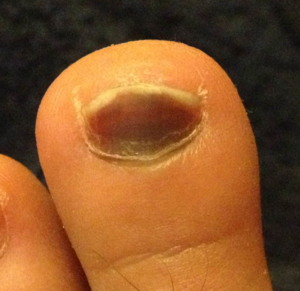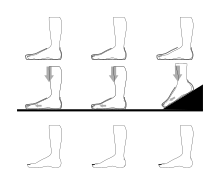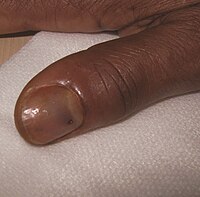Subungual hematoma
| Subungual hematoma | |
|---|---|
| Other names: Runner's toe, tennis toe, skier's toe | |
 | |
| Subungual hematoma of a toe | |
| Specialty | Emergency medicine |
| Symptoms | Discoloration of nail, pain[1] |
| Duration | Several months[2] |
| Causes | Injury, tumor[1] |
| Diagnostic method | Based on examination[3] |
| Differential diagnosis | Melanoma, naevus[3] |
| Treatment | Drilling a small hole in the nail[1] |
| Prognosis | While grow out over few weeks[1] |
| Frequency | Common[4] |
A subungual hematoma is a collection of blood underneath a fingernail or toenail.[1] It can be painful.[1] The discoloration of the nail may range from reddish to purple to black.[5] The injury may be complicated by a fracture of the finger tip or a mallet finger.[1]
The cause is generally a direct blow or crush injury to the finger tip.[1] Other causes may include repetitive injury such as from poorly fitting shoes, certain tumors and splinter hemorrhages.[1][3] Risk factors include anticoagulants (blood thinners).[2]
Treatment of painful cases as a result of injury is by drilling a small hole in the nail.[1] This can be done by rotating an 18 gauge needle.[1] A digital block may be done for pain, but is generally not required.[1] Antibiotics are generally not needed.[1] People may still eventually lose the nail.[1] These injuries are common.[4]
Signs and symptoms
A nail bed laceration causes bleeding into the constricted area underneath the hard nail plate.[6] The blood pools under the nail, giving a reddish, brownish, blueish, or grey/blackish discoloration. The blood puts pressure on the nail. Throbbing pain is common.
Subungual hematomas typically heal without incident, though infection may occur. The pressure of the blood blister may cause separation of nail plate from the nail bed (onycholysis), but the nail should not be pulled off, as this can cause scarring of the nailbed and deformed nails.[7] Nail discolouration may last some months.[8]
The nail plate may also become thicker and more brittle as a result of the injury (onychochauxis). The deformed nail plate will gradually grow out and be replaced by new, normal-appearing nail plate in several months' time.
Causes


The condition is caused by a traumatic injury, such as slamming a finger in a door,[9] or from sports activities, especially those involving sudden accelerations, such as soccer, basketball, and tennis, or going downhill, such as running or hiking rugged terrain,[10] and ill-fitting footwear.[8][7][11]: 52, 135
Repeatedly thrusting the toes against a shoe's toe box can cause a subungual hematoma called jogger's toe[12] runner's toe, or black toenail. In a marathon, several percent of runners may be affected.[8] Wearing footwear which fits helps prevent runner's toe.[8]
If the shoe is too loose on the midfoot, the foot can slide forwards in the shoe, especially when going downhill. This may jam the toes into the end of the toebox.[8] If the foot is sliding forwards because the shoe is too loose around the midfoot, it may be restrained by lacing the shoe carefully, or placing bulky padding between the tongue and the lacing, or by wrapping a strap in a figure-eight around the foot and ankle (image).[11]: 86–87, 128, 142 Excessively tight or uneven fit around the midfoot may, however, cause tendon problems.[11]: 125
Separately, if there is not enough space around the toes, the toes will also hit the toebox repeatedly.[8] Feet become longer and wider when weight is put on them, because the arches flatten, and the toes also splay and bend.[11]: p15, 18, 72–73 At the end of a long journey on foot, the arches flatten, the metatarsals spread, and the foot swells more than after a short one.[11]: 52 The toes also need vertical space; a toe cap which is low enough to press on the top of the toe may also cause bruising under the nail, especially if the toe cap is stiff. If the toebox is pointed, the toes may be wedged forwards into the area with inadequate height.[11]: 52–53, 135
Nails which protrude unevenly may concentrate force on the toenail; properly-cut nails are therefore also important.[8]
Some susceptible runners may also have Morton's toe. In this variant of human foot anatomy, the second toe extends further out than the great toe. This can make it harder to find shoes with adequate space around the toes.
Treatment
Subungual hematomas can resolve on their own, without treatment being necessary.[8] If they are acutely painful,[13] they may be drained.[1]
Drainage is generally by drilling a hole through the nail into the hematoma (trephining) within 48 hours of injury,[1] or by removing the entire nail. Trephining is generally accomplished by gentle drilling a whole by twirling an 18 gauge needle. Removal of the nail is occationally done when the nail itself is disrupted, a large laceration requiring suturing is suspected, or a fracture of the tip of the finger occurs. Although general anesthesia is generally not required, a digital nerve block is recommended if the nail is to be removed. For trephination, the block is often more painful than the procedure.[1]
See also
References
- ↑ 1.00 1.01 1.02 1.03 1.04 1.05 1.06 1.07 1.08 1.09 1.10 1.11 1.12 1.13 1.14 1.15 1.16 Pingel, C; McDowell, C (January 2021). "Subungual Hematoma Drainage". PMID 29494114.
{{cite journal}}: Cite journal requires|journal=(help) - ↑ 2.0 2.1 Tosti, Antonella (27 March 2018). Nail Disorders. Elsevier Health Sciences. p. 53. ISBN 978-0-323-54434-4. Archived from the original on 29 August 2021. Retrieved 12 July 2021.
- ↑ 3.0 3.1 3.2 "Subungual haemorrhage | DermNet NZ". dermnetnz.org. Archived from the original on 7 May 2021. Retrieved 12 July 2021.
- ↑ 4.0 4.1 Baran, Robert; Hadj-Rabia, Smail; Silverman, Robert (26 October 2016). Pediatric Nail Disorders. CRC Press. p. PT386. ISBN 978-1-4987-2047-2. Archived from the original on 29 August 2021. Retrieved 12 July 2021.
- ↑ Bolognia, Jean L.; Schaffer, Julie V.; Duncan, Karynne O.; Ko, Christine (2021). "58. Nail disorders". Dermatology Essentials (2nd ed.). Elsevier. p. 566. ISBN 978-0-323-62453-4. Archived from the original on 2024-01-20. Retrieved 2024-01-17.
- ↑ Selbst SM, Attia M (2006). "Lacerations". Textbook Of Pediatric Emergency Medicine. Hagerstown, MD: Lippincott Williams & Wilkins. p. 1571. ISBN 978-0-7817-5074-5.
- ↑ 7.0 7.1 "3 Tips to Protect Your Toenails If You're a Hard-Core Runner". Health Essentials from Cleveland Clinic. 3 December 2015. Archived from the original on 28 March 2021. Retrieved 27 March 2021.
- ↑ 8.0 8.1 8.2 8.3 8.4 8.5 8.6 8.7 Mailler, EA; Adams, BB (August 2004). "The wear and tear of 26.2: dermatological injuries reported on marathon day". British Journal of Sports Medicine. 38 (4): 498–501. doi:10.1136/bjsm.2004.011874. PMC 1724877. PMID 15273194.
- ↑ "Subungual Hematoma: Care Instructions". myhealth.alberta.ca. Archived from the original on 2021-07-21. Retrieved 2021-03-27.
- ↑ "Subungual Hematoma: Causes, Symptoms, Pictures, Treatment, and More". Healthline. Archived from the original on 2021-04-26. Retrieved 2021-03-27.
- ↑ 11.0 11.1 11.2 11.3 11.4 11.5 Munson, Edward Lyman (1912). The soldier's foot and the military shoe; a handbook for officers and noncommissioned officers of the line. Menasha, Wis.: Press of the George Banta publishing company. (this is the publication of a four-year review into the footwear of the US military by the Army Shoe Board, of which the author, a physician and senior officer of the United States Army Medical Corps, is president.
- ↑ Mailler, E A; Adams, BB (2004). "The wear and tear of 26.2: dermatological injuries reported on marathon day". British Journal of Sports Medicine. 38 (4): 498–501. doi:10.1136/bjsm.2004.011874. PMC 1724877. PMID 15273194.
- ↑ Dean, B; Becker, G; Little, C (2012). "The management of the acute traumatic subungual haematoma: a systematic review". Hand Surgery. 17 (1): 151–4. doi:10.1142/S021881041230001X. PMID 22351556.
External links
| Classification | |
|---|---|
| External resources |

